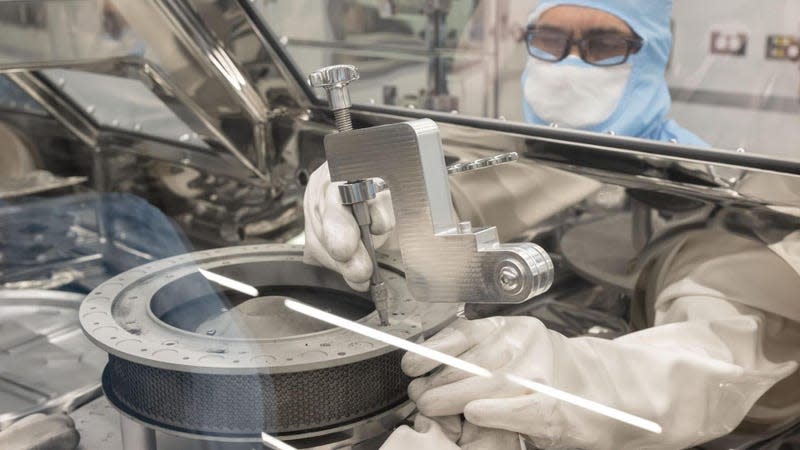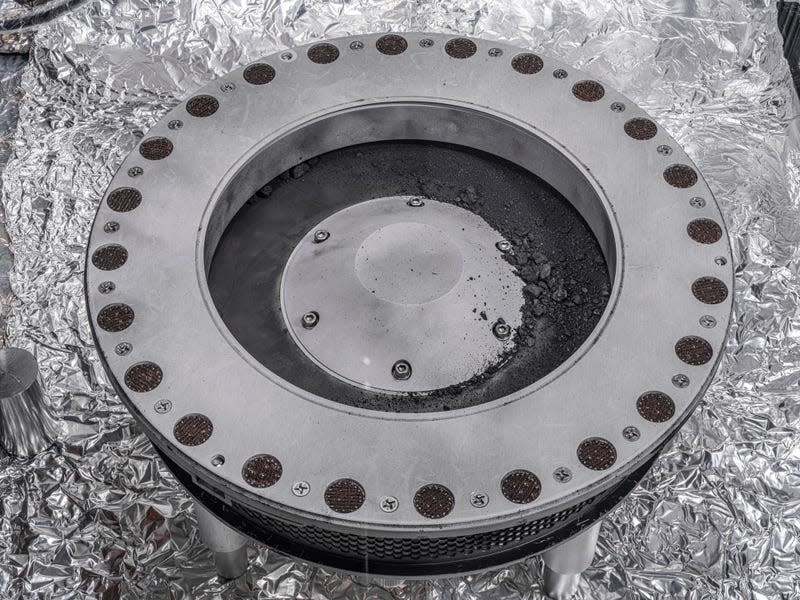NASA Scientists Finally Undo Stubborn Screws To Reveal Ancient Asteroid Sample

NASA scientists now know the ecstasy of unscrewing a stubborn fastener. For months, the last two screws on the lid of the container that held samples from NASA’s OSIRIS-REx mission had prevented researchers from accessing rocks and dust of the 4.6-billion-year-old asteroid Bennu. The screws simply wouldn’t budge and were in danger of becoming stripped, if not having done so already. Researchers had to develop and test special tools to finally undo the fasteners while preserving the integrity of the asteroid sample, according to NASA.
Scientists had managed to remove 33 of the 35 fasteners on the lid shortly after retrieving the container when it returned to Earth in late 2023. But the last two screws were uncooperative, which would ordinarily pose no problem for some of the world’s smartest gearheads. Except that NASA scientists couldn’t try the tricks people swear by when a fastener threatens to pit or deform, because the sample container is inside a glovebox that protects it from Earth’s atmosphere.
Read more
'Stupid Waste of Time': Sounds Like Subway's Expensive Automatic Meat Slicers Are a Bust
Netflix Is Doing Great, So It's Killing Off Its Cheapest Ad-Free Plan for Good
In response, two new multi-part tools were designed and fabricated to support further disassembly of the TAGSAM head. These tools include newly custom-fabricated bits made from a specific grade of surgical, non-magnetic stainless steel; the hardest metal approved for use in the pristine curation gloveboxes.
“In addition to the design challenge of being limited to curation-approved materials to protect the scientific value of the asteroid sample, these new tools also needed to function within the tightly-confined space of the glovebox, limiting their height, weight, and potential arc movement,” said Dr. Nicole Lunning, OSIRIS-REx curator at Johnson. “The curation team showed impressive resilience and did incredible work to get these stubborn fasteners off the TAGSAM head so we can continue disassembly. We are overjoyed with the success.”

NASA goes on to explain that the tools underwent extensive testing and development, complete with mock trials:
Prior to the successful removal, the team at Johnson tested the new tools and removal procedures in a rehearsal lab. After each successful test, engineers increased the assembly torque values and repeated the testing procedures until the team was confident the new tools would be able to achieve the torque needed while minimizing the risk of any potential damage to the TAGSAM head or any contamination of the sample within.
The NASA scientists rejoiced when the two fasteners were finally undone, celebrating by posting their success on Twitter (otherwise known as X.)
Success! 🙌
Innovation and patience have paid off and the two fasteners on the OSIRIS-REx asteroid sample mechanism have been removed, making way to access the final portion of precious material.
Read more: https://t.co/xcktcedsqj pic.twitter.com/J0DXMqunAT— NASA Astromaterials (@Astromaterials) January 11, 2024
Now that the container is open and NASA scientists have felt the relief of defeating a stubborn or stripped screw, the Bennu samples will undergo analysis before being cataloged and hermetically sealed for preservation. Researchers say the asteroid samples contain some of the oldest materials formed in the solar system.



More from Jalopnik
5 players from 2018 WJC team to be charged with sexual assault
R.I.P. Gary Graham, Star Trek: Enterprise and Alien Nation actor
Modeler Who Compared Palworld And Pokémon Critters Denies Fabrication Accusations
20 great (and 5 not-so-great) sophomore films from famed directors
Sign up for Jalopnik's Newsletter. For the latest news, Facebook, Twitter and Instagram.

 Yahoo Autos
Yahoo Autos 